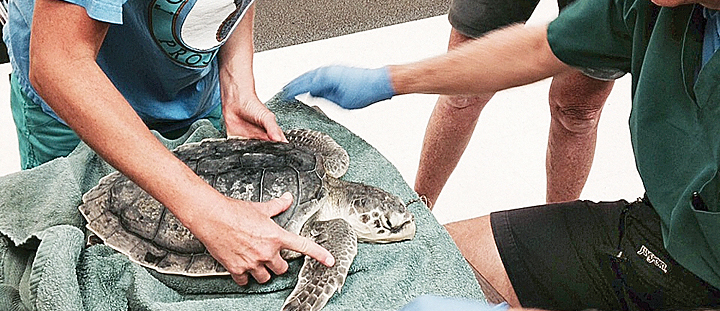By Jamie Lynn Miller
Contributing Writer
Thus far along the North Carolina coast, the New Year has washed up a record number of cold-stunned turtles in need of rescue and rehabilitation.
It’s only mid-January, and already 800 to 1,000 distressed turtles have been discovered off North Carolina beaches.
“It’s a truly unprecedented situation,’ said Nancy Fahey, coordinator for Wrightsville Beach’s Sea Turtle Project. “In just two days, there were more than 600 turtles unable to swim to shore, due to the suddenly frigid water temperatures,” she added.
Turtles have a small body mass, Fahey explained, and when waters cool so rapidly, the turtles are unable to acclimate. The rapid temperature change causes a hypothermic response, almost a paralysis, and the turtles find themselves in a potential death trap, literally stunned by the cold, unable to migrate to warmer waters in time.
Around the size of a dinner plate, young green turtles, even Kemp’s ridley turtles, are most endangered; loggerhead turtles have a bit more body mass, but they too need to get to the warmth in time.
To date, the majority of the cold-stunned activity is happening around the Outer Banks — with large areas of bay, estuary, and sound, the waters around the Outer Banks provide fertile fall foraging for many sea turtles. Come winter, the turtles must swim out of those bays and estuaries and into the Gulf Stream, a virtually impossible feat in their suddenly frozen state.
With rescue efforts taking place up and down the state’s coastline, rehabilitation efforts range from administering antibiotics and amniotic fluids, to performing ongoing health checks. First and foremost, however, the turtles are gradually, incrementally warmed — like cooling too rapidly, too much warmth too soon can send the sea turtles into shock.
Like all things beach-related, real estate is precious, and limited; turtles are being housed wherever “beds” are being created, in aquariums and refuges across the state. Holding centers include the North Carolina Aquarium at Fort Fisher, which is currently caring for 11 sea turtles, while the Karen Beasley Sea Turtle Rescue and Rehabilitation Center in Surf City is rehabilitating as many as 46 sea turtles.
Warmed, nurtured, and given a clean bill of health, the sea turtles must still find their way to warmer waters. The four-flippered portion of the journey is yet to come.
“We can’t release the animals right back into the surrounding waters,” Fahey said, of the next step in the process. If local waters aren’t yet balmy enough the Coast Guard might shuttle the turtles out to the Gulf Stream, or, like other, less amphibious cold-stunned beings, the turtles — assisted by modern-day transport — will head south for the winter, to the waters off the Florida coast. Prior to release, each turtle is equipped with a microchip tag so that researchers and turtle volunteers can track its progress throughout its new journey.
Because local waters are more of a summer feeding ground, a “hot spot” for juvenile green turtles before fall foraging around the Outer Banks, cold-stunned turtles haven’t yet washed up along local beaches. But they could.
Indeed, with more winter ahead, the sea turtles are still at risk. This winter’s abnormally high fall temperatures, which lingered through December, followed by January’s sudden transition to winter continues to shock North Carolina’s sea turtle population.
“We haven’t had any reports around Wrightsville yet, but that doesn’t mean there won’t be any,” Fahey says. “We’re expecting more cold weather, so we ask that locals please keep an eye out. If you see turtles that look lethargic, or any turtles at all, please let us know so we have a chance to save them.”
To report findings or turtle-related activity, call the sea turtle hotline at 252-241-7367.




